I bet you’ve seen this sort of advice before…
When using a testimonial, you should always:
- List the customer’s first and last name
- Include their photo
- Avoid unbelievable, over-the-top praise
Those are all fine tips to follow, but they’re really just starting points.
Optimizing your social proof requires just as much strategy and testing as improving a headline, hero image or call-to-action button.
Because if you just stick to blindly following ‘best practices,’ you could be missing out on a huge opportunity to squeeze more conversions out of your website or landing page. Here’s why:
Social proof affects different audiences in different ways. The complexity of your offer, the demographics of your visitors and a host of other factors all influence how persuasive your testimonials will be.
And that means you may want to try optimizing them in ways that seem counterintuitive at first.
Or even just plain strange.
I’ll get into more detail about this in a moment. But first, let’s make sure we’re on the same page about what typically makes for a convincing and credible testimonial.
Don’t use testimonials unless you’ve seen these tips…
Plenty of articles have already been written offering great advice for using testimonials. And those tips can generally be summed up as:
- Include a photo and other details
Providing the customer’s first and last name, location or any other relevant details makes testimonials more realistic. But an even bigger factor is including a (real) photo of the testimonial-giver. There’s plenty of research to back this up. - Use testimonials from people your customers can relate to
According to implicit egotism theory, we generally trust people who are either like us or who we aspire to be like. And that means strong testimonials are often from folks who reflect how your prospects see themselves. - Use testimonials from people with authority (if possible)
The most powerful testimonials come from people your audience sees as an expert or otherwise having authority. In essence, you’re ‘borrowing’ the positive feelings people have toward these individuals (this is called the Halo Effect) when you get their endorsement. - Reinforce a specific benefit
Emphasis on specific. Vague testimonials that say things like “great experience” or “tremendous value” won’t connect with anyone. And it might even hurt your conversion rate. Instead, testimonials should be used strategically as ‘proof’ to support specific claims you’re making on your pages. -
OR
- Quash a serious objection
Research by MECLABS shows that placing testimonials near sources of anxiety (such as the ‘Add to Cart’ button) can ease objections and improve conversions. Bottom line: don’t just randomly sprinkle testimonials throughout your website. First, consider the role they’re playing on the page.
These tips make sense, right?
And if you’ve been in the conversion optimization game for any length of time, I suspect you’re already familiar with most of them.
Now, let’s dive into 3 lesser-known techniques for making your testimonials more credible, engaging and persuasive.
1) Try ‘long-form’ testimonials
Far too many articles give out generic advice like:
“Always keep your testimonials very short.”
Well, no. Not always.
Short, specific quotes from customers may work fine in certain situations. But sometimes a big, juicy testimonial can provide the exact dose of social proof that your page needs. Why?
For the same reasons that long copy can sometimes be more persuasive than short copy. Long-form sales messages often work great when your product is complicated, your audience has loads of objections or the price-tag is high.
As veteran ad man Jay Conrad Levinson puts it:
“Don’t be afraid to use lengthy copy. Of all the things people dislike about marketing, ‘lack of information’ comes in second, after ‘feeling deceived.’”
The trick is to ensure your long-form copy — or long-form testimonial — is interesting and relevant to your audience. Here’s an example:
Long-form testimonials make up the majority of content on Noah Kagan’s sales page for his How To Make A $1,000 A Month Business course. And some of them run well over 500 words!
Now, these testimonials work like sales copy in a number of different ways. But I want to point out one specific technique that makes them so effective: storytelling.
Several testimonials on the page tell raw, human stories about a problem the person was up against and how they discovered a life-changing solution thanks to Kagan’s course.
Take a look at this example:
Dave’s story kicks off with an emotional (and relatable) problem.
He then goes on to tell a story about how the course helped him, eventually building to the ‘climax’ detailing how his life changed afterwards:
In fact, some of the most effective long-form testimonials start with an emotional problem.
Here’s a prime example from the Sweat Block homepage, which was optimized by the team at Copy Hackers. This testimonial follows the tried-and-true problem-agitate-solve copywriting formula:
Now, a customer probably isn’t going to just hand you over a problem-agitate-solve testimonial by fluke. You may need to give them some guidance first.
So ask specific questions when requesting a testimonial. Things like:
- What made you seek out our product/service?
- What was the exact problem you needed to solve? How did it impact your life?
- How did our product/service solve this problem? How did it improve your [business/social life etc.]?
But even if you don’t take a problem-focused approach, the key to using effective long-form testimonials is to make sure they tell a gripping story.
One that will resonate with your target audience in a powerful way.
2) Show your warts (really, it’s OK)
Don’t get me wrong: I’m not saying you should post a testimonial that outright bashes your company.
That’d be weird. And, well, kind of dumb.
But I am suggesting that by leaving some minor ‘warts’ in your testimonials you can convey trust and credibility — if you do it the right way.
One study found that 68% of consumers trust reviews more when they see both positive and negative scores. And a whopping 30% suspect faked reviews when they don’t see anything negative at all.
As master copywriter Bob Bly puts it, “showing your warts” can be an effective marketing technique provided you:
- demonstrate why your product’s weakness isn’t important or
- show how you’ve designed your product to overcome the weakness
This tactic works because arguing against your own self-interest builds credibility.
In this Unbounce article, marketer and entrepreneur Pratik Dholakiya suggests testing a landing page testimonial that tells people who your product isn’t right for. This might involve including a line like:
“This product isn’t for [so and so], it’s for [so and so].”
The beauty of this approach is that it sends the message you want happy, long-term customers; not just quicks sales for short-term gain.
Some brands have used not-so-shiny testimonials in more creative ways to reinforce a key message.
For example, Ship Your Enemies Glitter used to feature a reviews section that told an unfiltered story about their product — one testimonial even mentioned a customer’s pending divorce.
OK, this is an extreme example.
The point is that people are skeptical of both online reviews and testimonials. But by slipping in a few “warts” (in a strategic way), you can give your social proof a shot of credibility.
3) Make your testimonial the ‘hero’
Got a beauty of a testimonial?
One that’s credible, relatable and aligns perfectly with the goal of your page?
Then don’t bury it way below the fold! Instead, play that sucker up big time in the hero section for every visitor to see.
Emphasizing the right testimonial immediately sends the message to prospects that your product solves problems for people who are just like them.
I used this strategy while optimizing a key sales page for LivePlan, which is a SaaS product that helps entrepreneurs write professional business plans.
Research showed us that many prospects had niggling doubts when they hit the page. They often wondered:
“Will this software work for my specific industry?”
It was a big barrier to signing up.
So we created a landing page that targeted just a segment of LivePlan’s traffic: people who wanted to write a business plan specifically for a café.
But instead of us telling the audience “this works for café entrepreneurs like you,” we wanted to prove it to them by making a relatable testimonial the hero of the page.
So we emphasized a quick story about how café owner Brian Sung used LivePlan to write a business plan faster and with less effort. Then we A/B tested the new page.
Here are the two hero sections we tested:
The testimonial-focused variant hauled in a 72% boost in paid conversions, which translated into a 53% increase in revenue (when you consider average order value).
There were a few other variables at play here. But ultimately, I believe that this relatable testimonial proved the hypothesis that LivePlan customers needed to feel confident that the product would work for their industry before signing up.
Other companies have also seen ‘wins’ by playing up testimonials like this as well. For example, Highrise saw a 102% lift in conversions when they tested a giant image and quote from one of their customers.
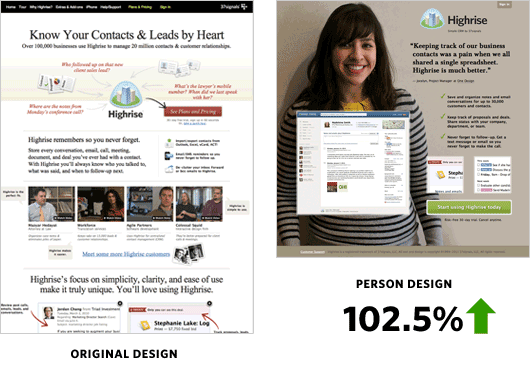
But again, having the right testimonials is key here. You can’t just pick one at random.
If you know headlines focused on “saving time” convert well, playing up a testimonial about how a customer “saved money” isn’t going to cut it.
Consider your goals and strategy for the page. Then select your social proof accordingly.
Conclusion
It doesn’t matter if you’re dealing with testimonials, user-reviews or client logos — the bottom line is the same:
Social proof affects different audiences in different ways.
Following best practices is a great starting point. But to squeeze the most persuasive value out of your testimonials, you need to consider things like your audience’s level of awareness and their thought sequence as they hit your page.
Now, maybe the 3 tactics outlined here aren’t a great fit for your prospects. That’s fine.
But it is important that you make an informed, strategic decision about how you use any type of social proof.
Because just tossing testimonials randomly on a page isn’t doing your visitors — or your conversion rates — any good.
About the author: Dustin Walker is a copywriter and partner at Good Funnel — a marketing agency that does in-depth customer research to help online businesses fire up their revenue. Follow Dustin on Twitter @dustinjaywalker.
from The Kissmetrics Marketing Blog https://blog.kissmetrics.com/making-testimonials-more-persuasive/
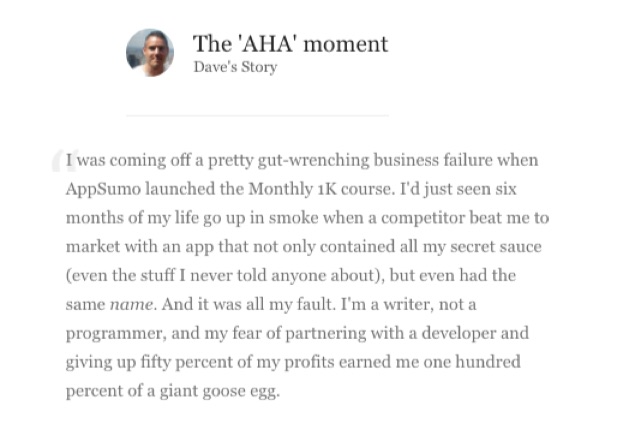

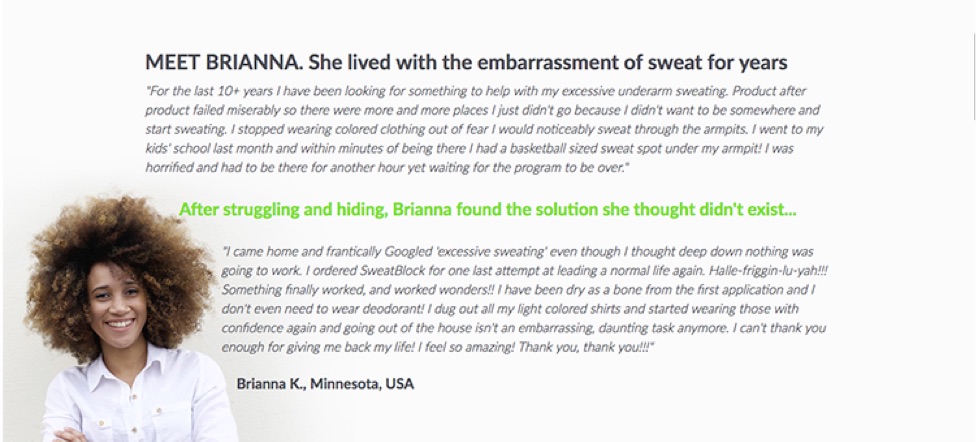
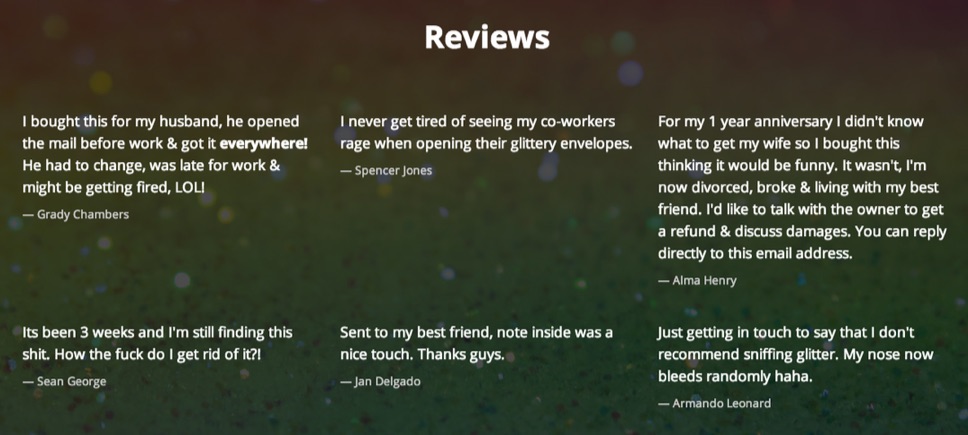
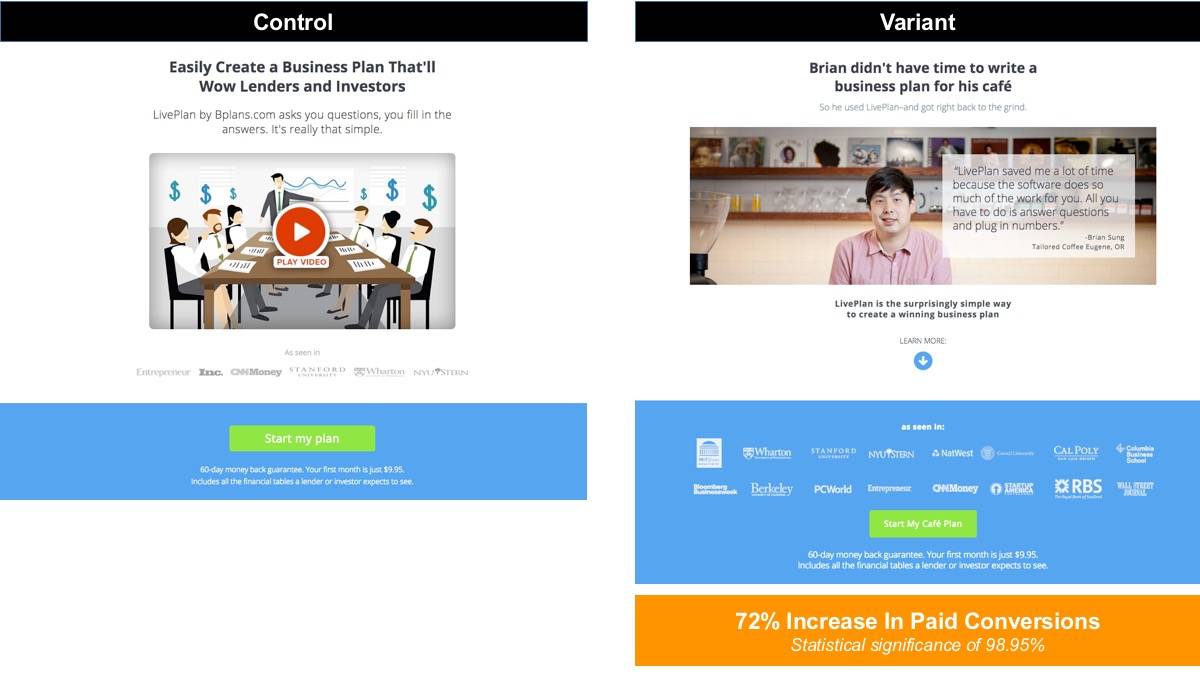
No comments:
Post a Comment